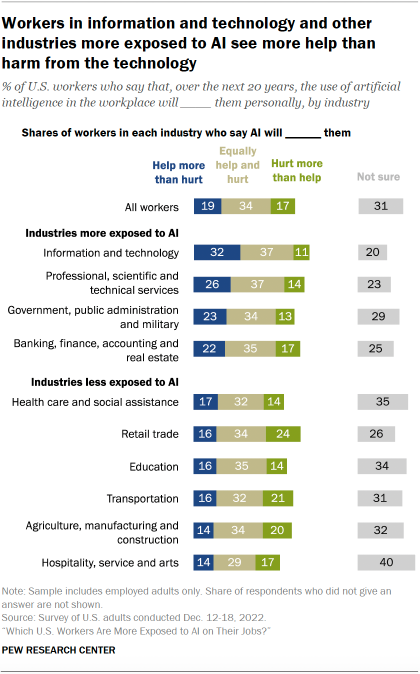CORRECTION (Jan. 25, 2024): A previous version of this report chapter included incorrect percentages in the second graphic and in corresponding text. Among all working U.S. adults, 19% say that over the next 20 years, the use of artificial intelligence in the workplace will help more than hurt them, personally; 34% say AI will equally help and hurt them; 17% say it will hurt more than help; and 31% are not sure.
One reason artificial intelligence will penetrate more deeply into some sectors of the U.S. economy than others is that the mix of jobs varies across industries.

We found in our analysis that about half of workers (52%) in the professional, scientific and technical services sector face a high degree of exposure to AI, more than double the rate for workers overall. Exposure is also much greater than average for workers in finance, insurance and real estate (37%) and public administration (36%).
At the other end of the spectrum, about half of workers (48%) in the other services sector, including repair, maintenance, personal and household services, are likely to experience little exposure to AI. More than four-in-ten workers in managerial and administrative services (45%) and accommodation and food services (43%) should see relatively minimal exposure to AI. These are sectors in which workers, like nannies, are more likely to engage in physical or social tasks. (The appendix provides a complete list of industries and their exposure to AI.)
Workers in more exposed industries see less risk to their jobs from AI
A recent Pew Research Center survey shows that many workers who are likely to see more exposure to AI do not necessarily feel their jobs are at risk. In particular, U.S. adults working in the most exposed industries are less concerned about the impact of AI on them personally.
In the survey, 19% of all U.S. working adults said they think AI will help more than hurt them personally over the next 20 years, and 17% said they thought AI would hurt more than help. But workers in different industries had notably different views on this question. Our new analysis shows that about one-third (32%) of workers in the information and technology sector said that AI will help more than hurt them personally. Another 37% said AI will equally help and hurt, and only 11% said it will hurt more than help.

Additionally, about one-in-four workers in professional, scientific and technical services (26%) said AI will help more than hurt, and 23% in government, public administration and military said the same.
In contrast, relatively few workers in hospitality, services and arts (14%) think AI will help more than hurt them personally. Four-in-ten workers in this sector are not sure about AI’s potential impact on them, which is among the higher shares across industries. There is a similar variance in the opinion of workers across industries about whether the use of AI in the workplace will help or hurt the U.S. economy (these estimates are in the appendix).
In a recent report based on our survey, we also found that many groups expected to be more exposed to AI are more optimistic about its impact on them. Notably, Asian adults, college graduates and upper-income workers were more likely than other workers to say they think the use of AI in the workplace over the next 20 years will help more than hurt them personally at the workplace. Women were half as likely as men – 11% vs. 22% – to say this, but they were also more likely than men to say they were not sure of AI’s potential impact on them personally.


